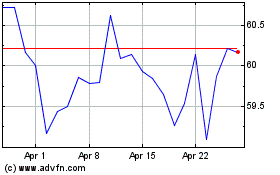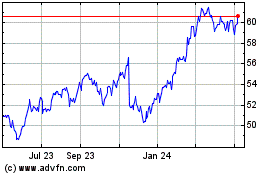By Sarah Nassauer
Walmart Inc. reported sluggish holiday sales despite continued
online gains, adding to a string of disappointments from
traditional retailers as they adjust to changing shopping
habits.
Walmart said U.S. comparable sales, those from stores and
digital channels operating for at least 12 months, increased 1.9%
in the fourth quarter, a slowdown compared with the 4.2% growth the
company reported for the same period last year.
The results showed the world's biggest retailer struggled to get
shoppers to spend in its stores during a shorter holiday selling
season as it ramped up efforts to compete with Amazon.com Inc.
Walmart's U.S. e-commerce sales rose 35% in the fourth quarter,
boosted by online grocery orders.
Walmart executives said the holiday season started strong around
Thanksgiving but blamed soft sales of toys, videogames and apparel
in the weeks before Christmas. Overall, consumer spending was
strong last year, government data show, but retailers' profits have
been pinched as orders shift online.
"We feel pretty good about the year even though the fourth
quarter was not our best," Chief Executive Doug McMillon said
during an investor presentation Tuesday. Store sales suffered from
a late Thanksgiving as well as some merchandising missteps, he
said.
There was a lack of high-price, in-demand holiday toys, Mr.
McMillon said, and Walmart stocked too many inexpensive clothes and
too much seasonal attire. "We looked like red and green and could
have been more basic and could of had some middle price points," he
said. January and February sales overall look stronger so far, he
said.
Walmart forecast another year of strong sales growth, predicting
U.S. comparable sales will increase at least 2.5% in fiscal 2021 --
after rising 2.8% in the year just ended. It expects U.S.
e-commerce growth for the year of 30%, less than the 37% booked in
2020.
Operating income fell 12.3% for the fourth quarter, to $5.3
billion, as the company continues to invest in its online
operations. Walmart has pinched spending elsewhere, adding more
automation to stores and laying off workers at some of its
unprofitable e-commerce brands.
Walmart executives used the start of a new fiscal year to share
plans to boost profits online, as well as create revenue sources
from new ventures such as digital advertising and a bigger
health-care business.
Health care, including new store clinics with more medical
services, represents another "opportunity that takes advantage of
big boxes and big parking lots close to people," Mr. McMillon told
investors Tuesday.
"We think we can learn how to drive alternative revenue and
profit streams by building on our core businesses," he said.
Walmart said it expects e-commerce losses to come in flat to
slightly better during the current fiscal year, after several years
of increasing losses. Like Amazon, Walmart will seek to expand the
number of third-party merchants that pay fees to sell through its
website.
To boost that business the company has started to offer Walmart
fulfillment services, U.S. e-commerce CEO Marc Lore said. Such
programs charge fees to warehouse and ship goods. Walmart shipped
the first such package using its own warehouse network last August,
a company spokesman said.
Overall, Walmart reported revenue rose 2% to $141.67 billion for
the three months ended Jan. 31, including gains in its
international markets and its Sam's Club warehouse chain. Net
income was $4.14 billion, up 12% from a year ago, including several
one-time tax items.
Walmart has fared better than most U.S. retailers in recent
years, as the retail giant ramps up online grocery orders and takes
market share from smaller chains like Sears that are closing
stores. In the U.S., more than half of Walmart's sales are food and
groceries, which are less susceptible to consumer swings.
The holiday season has been a disappointment to most traditional
retailers. Target Corp. fell short of its own expectations, citing
weak sales in toys and electronics. Macy's Inc. recently said it
would close another 125 of its department stores.
Due to a late Thanksgiving, there were six fewer days in the
2019 holiday-shopping season compared with 2018, which may have
eaten into sales, said retail analysts.
Walmart shares, which are trading near all-time highs, gained
about 1.5% in Tuesday afternoon trading. The stock rallied roughly
30% last year.
In recent weeks retail analysts have been lowering their
expectations for Walmart's sales and profits, after publishing
largely optimistic reports last year. Although the quarterly sales
growth and profits missed earlier forecasts, the results weren't as
weak as some had feared.
For the fourth quarter, Walmart reported adjusted earnings per
share of $1.38, below the consensus estimate of $1.44. For fiscal
2021, the company predicted adjusted earnings of $5 to $5.15 a
share, a slight increase from 2020, but below Wall Street's
expectations of $5.22.
Walmart, which operates hundreds of stores in China, said it
continues to monitor the coronavirus outbreak but hasn't included
any potential financial effects in its guidance for the current
fiscal year. Apple Inc. warned Monday it would miss its March
quarter financial targets due to the outbreak.
Write to Sarah Nassauer at sarah.nassauer@wsj.com
(END) Dow Jones Newswires
February 18, 2020 15:07 ET (20:07 GMT)
Copyright (c) 2020 Dow Jones & Company, Inc.
Walmart (NYSE:WMT)
Historical Stock Chart
From Mar 2024 to Apr 2024

Walmart (NYSE:WMT)
Historical Stock Chart
From Apr 2023 to Apr 2024
